Madrid’s Royal Palace is splendour manifested as a larger-than-life, imperial home. No wonder, the 18th-century edifice remains, even today, the official residence of the Spanish monarchs and is the site of state visits. Borrowing heavily from architectural innovations that evolved in France and Italy, the makers of the Royal Palace of Madrid lavished this expansive set-up with unbridled gilding details, ceiling frescoes that highlighted the empire’s glory, and covered entire rooms with astonishing embroidered satins and silks that made for unbelievably plush dwellings. A must-visit on your trip to Madrid, the Royal Palace can easily overwhelm the unsuspecting visitor, which is why you need to read this detailed guide that unpacks this historical marvel.
Essential information for visiting the Royal Palace of Madrid

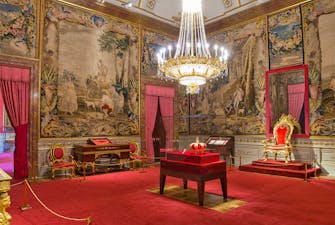
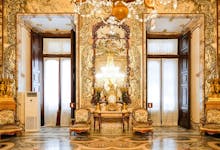
Handy information
| ⏰ Suggested Duration: | 3 hours |
| ☀️ Best Time to Visit: | Early morning |
| 💜 Must-see: | Throne Room |
| 🎟️ Royal Palace of Madrid entry ticket: | €12 onwards |
Must-see
Sabatini Gardens
Plaza de la Armería
Royal Armory
The Crown Room
Things to know
Number of visitors: Close to 2 million visitors per year
Built: 1738 – 1755
Principal architect: Filippo Juvarra
Architectural style: Baroque, classicism
Opening Hours And Address
October to March:
Monday to Saturday: 10am to 6pm
Sunday: 10am to 4pm
April to September
Monday to Saturday: 10am to 7pm
Sunday: 10am to 4pm
Address: C. de Bailén, s/n, 28071 Madrid, Spain
Get Directions
Why you must visit the Royal Palace of Madrid
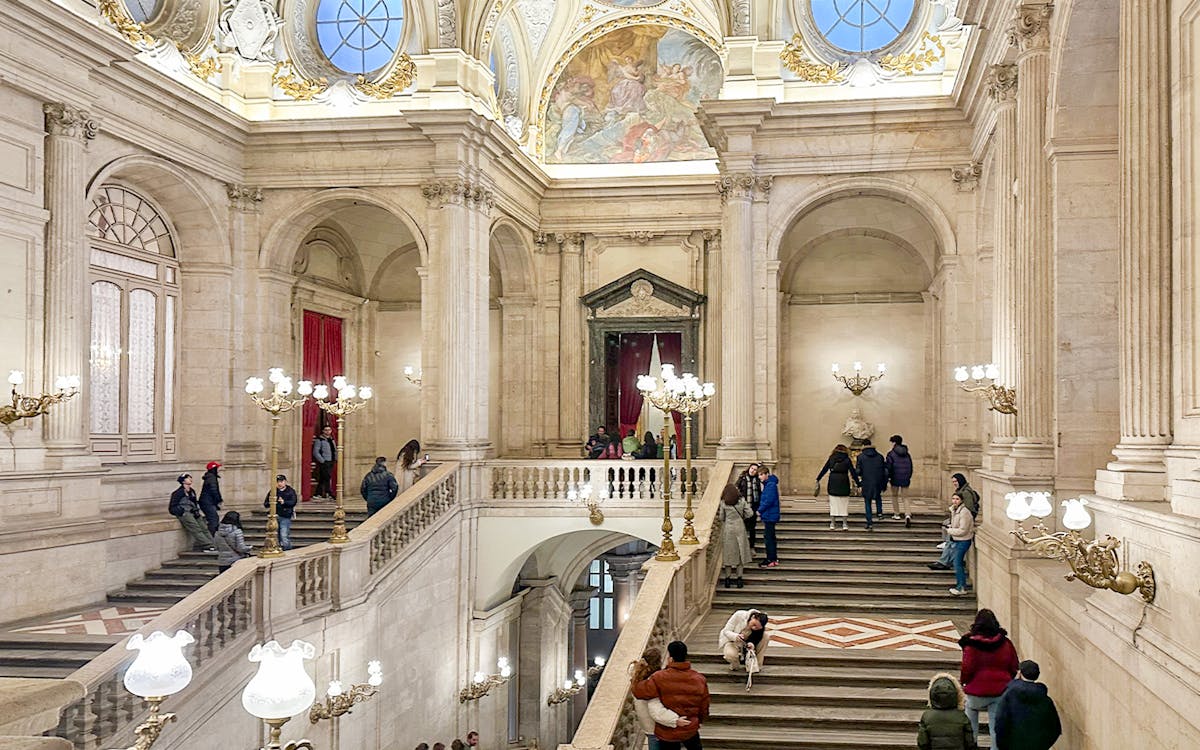
An unforgettable showcase of opulence, the Royal Palace of Madrid is one of Europe's most magnificent edifices. Built in the 18th century, this palatial abode remains the largest palace in all of Western Europe. While it is the official residence of the Spanish monarchy, it is only occasionally used by the royal for state functions. However, each day, the gates are thrown open to throngs of visitors who come to take in the lavish rooms decorated with lush furnishings and frescoes, and embellished with gildings. Also vying for attention are masterpieces from Goya, a throne room that befits the kings, a shiny armoury, and endless sparkling chandeliers. When you’ve had an eyeful of the Palace’s over-the-top interiors, you can stop by the surrounding gardens that offer tranquillity.
Know before you purchase tickets to the Royal Palace of Madrid
The monument receives close to 2 million visitors each year. To avoid disappointment and the crowds at the ticket window, we recommend you pre-book your tickets in advance.
Tickets to the Palace also grant you access to the gardens, so make sure you stop by for a breath of fresh air and to take in the well-maintained grounds.
The Royal Palace of Madrid is steeped in history, and each room has historical and architectural significance. A guided tour will unpack all the details of the monument, ensuring a full experience.
For a few extra euros, you can sign up for audio tours that share information on the Palace and its many rooms. Available in various languages, the audio tours will help you make the most of your experience on a budget.
If you are planning to buy tickets onsite, do note that they do not accept €200 €500 bills.
Recommended tickets to Royal Palace of Madrid
The Royal Palace of Madrid’s history
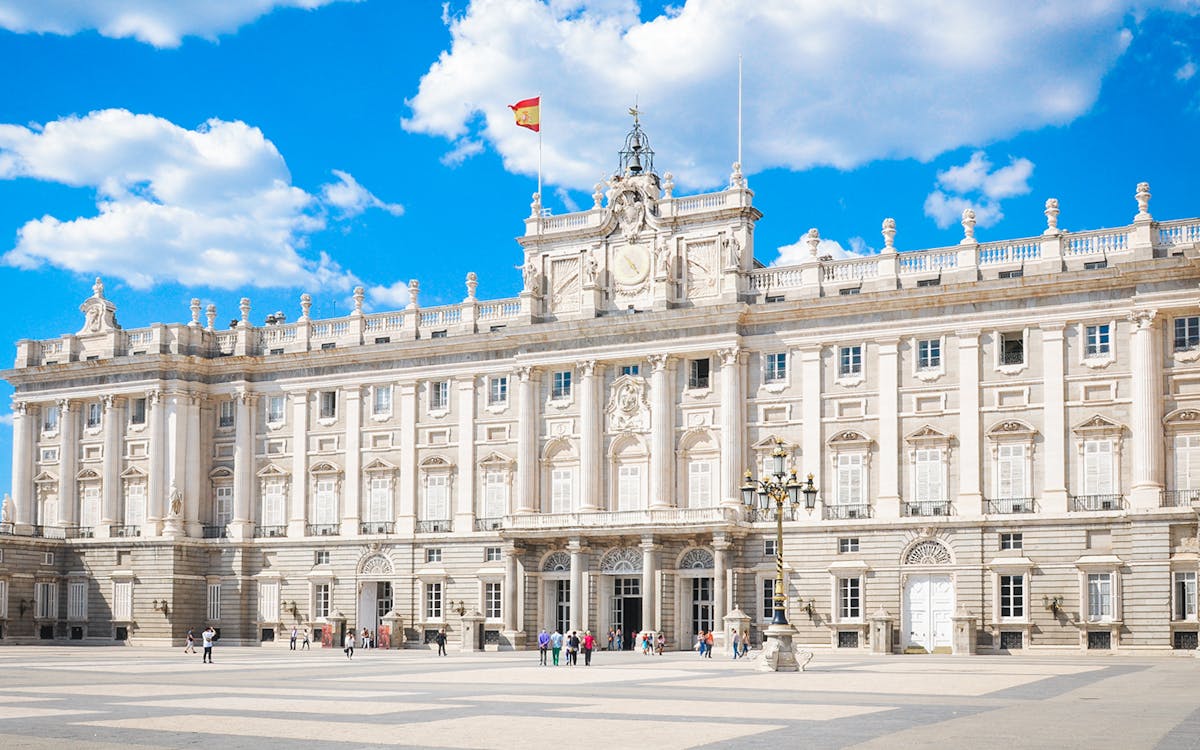
Long, long ago, in the 800s, a Moorish-era alcazar stood at the same site where the Royal Palace of Madrid stands today. For centuries, the Alcazar was passed down to the rulers of the region until the fateful Christmas Eve in 1734, when the structure burned to the ground.
Philip V, the first of the Bourbon dynasty, who ruled Madrid during the time of the ill-fated fire seized the opportunity to rebuild the palace according to his over-the-top desires. Having spent his childhood in France, the monarch sought to recreate the Palace of Versailles in Spain’s heartland. And to fulfil his vision, he brought on board architect, Filippo Juvarra, who also drew inspiration from France’s Louvre to design a dream palace in the Baroque style.
However, the lavish Palace remained unfinished at the time of the deaths of Philip V and Juvarra, and it fell on successive kings and architects, including, to finish up the project. After enlarging the edifice, Charles III became the first to move in in 1764.
The Royal Palace continued to see modifications and renovations through the centuries, taking on other European-style flourishes. The Sabatini Gardens which were added in 1933, were one of the last major additions to the colossal structure.
Today, the Royal Palace sits on a whopping 1, 450,000 sq feet, has 3,418 rooms and is one of Europe’s best-known royal residences.
The Royal Palace of Madrid’s architecture
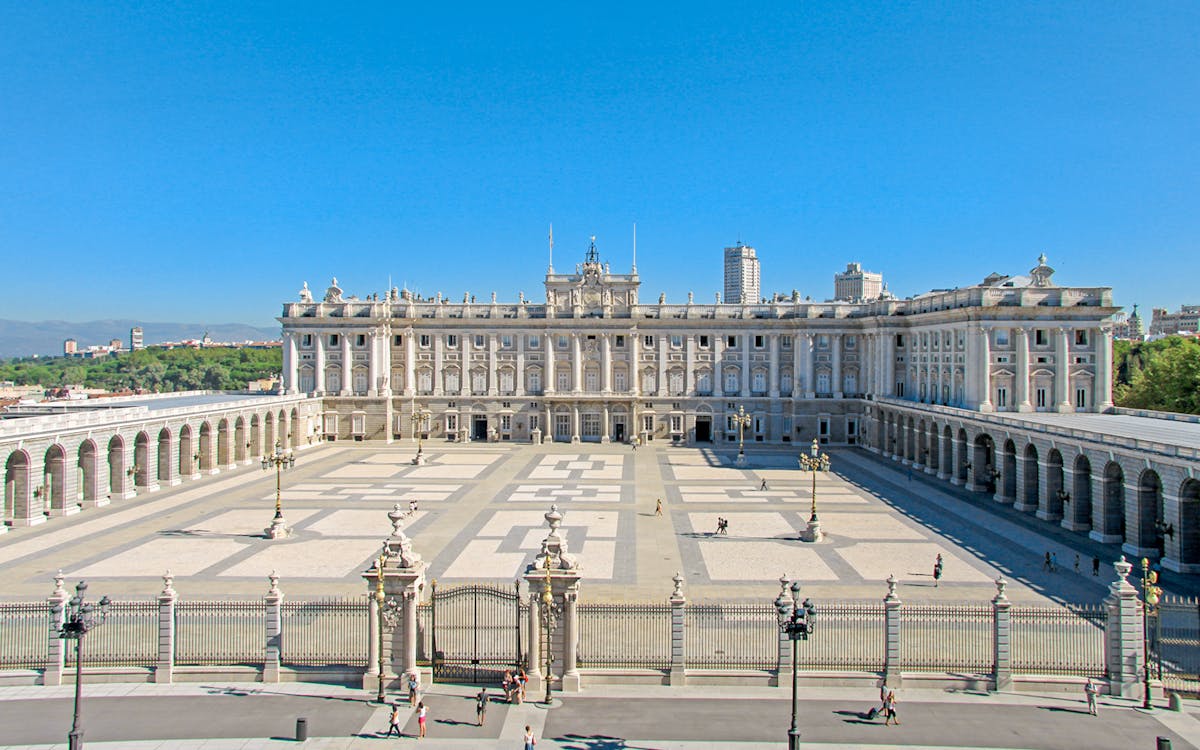
Conceptualised to rival the grand palaces of France, Madrid’s Royal Palace was envisioned in the Baroque style by Filippo Juvarra. Its colonnaded exteriors evoke the Louvre Palace while the grand, gilded interiors remind you of the Palace of Versailles.
To prevent the palace from suffering the same fate as the burnt-down Alcazar that stood at the same site previously, it was built in stone under the supervision of Giambattista Sacchetti, who took over as the architect after Juvarra’s passing.
In 1764, after Charles III moved into the completed palatial residence, the Royal Palace’s interiors’ glamour quotient was scaled up with Italian-style frescoes by artists like Giambattista Tiepolo and Anton Raphael Mengs. From wall to ceiling, the Palace was also embellished in the over-the-top rococo style that ensured that pretty much every inch of the palace was adorned in motifs and gilding.
The final touches were added by Ferdinand VII, who furnished the Palace with neoclassical, French furniture and larger-than-life crystal and bronze chandeliers.
Your Royal Palace of Madrid tour deconstructed
While there are close to 3,500 rooms in the Royal Palace of Madrid, only about fifty are open for public viewing. Still, that is plenty to keep you occupied for the better part of two to three hours. Here is a list of must-sees during your Royal Palace of Madrid tour.

Making a grand first impression was clearly important to the Spanish monarchs! And the Palace’s sweeping main staircase stands testament to that. As you enter this royal abode, the stairs are topped with high vaulted ceilings covered in frescoes garlanded with gildings and stucco work, its bannisters guarded by lions sculpted in marble, and the walkway lit up by a series of lamps.

In 1759, Mattia Gasparini, an Italian artist, arrived at the Royal Palace of Madrid to give the king’s chamber a makeover. The resulting salon will surely have you ‘Gasp’ing! The Rococo-style walls of the room are covered in embroidered satin featuring a dizzying pattern of vines, flowers, leaves, and birds. These spill over to the furniture, the frescoed ceiling, and the decorated marble flooring, ensuring the room comes together to look like a royal wonderland.

The Palace’s centrepiece, the Throne Room, covered in a deep-red, embroidered Genoese velvet, exudes royalty. On a platform, sits a pair of thrones while the rest of the room is adorned with sculptures, mirrors, and carved furniture. Look up and you’ll see Tiepolo’s dreamy fresco – The Triumph of the Spanish Monarchy.

Here you’ll find all the knights in shining armour you need! Housed in a large, rectangular room, painted in red and displaying large tapestries, the Armoury showcases Spain’s military lineage through the centuries. The Armoury is lined with knighted figures mounted on wooden horses, brandishing spears and swords. Also on display are military trophies, gifts, and weapons from the personal collection of Spain’s monarchy.

A vast square that sits in front of the Palace, the Plaza de la Armería is an excellent spot to get wide-angle photos of the palace and stroll around admiring the exteriors of the Palace. Across the square, Almudena Cathedral beckons.

One of the last additions to the palatial complex, the Sabatini Gardens, named after one of the key architects of the Palace, is a serene spot to catch your breath after you’ve toured the ostentatious palace. The gardens were once occupied by the royal stables but were converted to a green oasis featuring pools and sculptures in 1933.
Best time to visit the Royal Palace of Madrid
Millions flock to the Royal Palace of Madrid, making it one of the most visited sites in the Spanish capital. We recommend early mornings or late evenings for a visit as the crowds tend to be leaner during these times.
In terms of season, we recommend spring (between April and June) or fall (between September and November). These are off-seasons, ensuring that you won’t have to weave through the hordes, and you’ll be able to pay greater attention to the beauty of the palace.
All you need to know before visiting the Royal Palace of Madrid
Opening Hours
October to March
- Monday to Saturday: 10am to 6pm
- Sunday: 10am to 4pm
April to September
- Monday to Saturday: 10am to 7pm
- Sunday: 10am to 4pm
The Palace is closed on several days of the year due to public holidays or when hosting State events. We recommend you check out the official website before making a booking.
Royal Palace of Madrid entrances
There are two entrances to the Royal Palace of Madrid. For individuals and small groups, access is through the door of the esplanade of the Almudena. The is located at the corner of Calle Bailén. Large groups can access the Palace through the Puerta Bailén door, which is located in front of Calle Requena.
Royal Palace of Madrid directions
- By bus: Routes 3, 25, 39 and 148 stop at Plaza de Oriente, which provides easy access to the Palace.
- By metro: Take lines 5 or 2 to the Ópera station. From here, the Palace is a short walk away.
- By train: Take the train to the Príncipe Pío Station. The Palace is a 15-minute walk from here.
Royal Palace of Madrid map
Insider tips for visiting the Royal Palace of Madrid
- If you are signing up for an audio guide, you can choose between in-depth, express, and children's mode to tailor the commentary to your visit.
- While tickets are usually available on-site, the lines at the ticket windows are lengthy. Book your tickets online and you’ll be able to access the monument much quicker.
- You can catch the Changing of the Guards ceremony every day at noon at the Plaza de la Armeria. However, do note that the ceremony does not take place in January, August and September and when the Palace is in official use.
- Access to the Royal Palace of Madrid is free between 5:00 and 7:00 p.m., Monday through Thursday. This works well if you are travelling to Madrid on a budget.
- The official website puts out a list of the days the Palace or part of the monument are closed every month. We recommend checking those before making a booking.
Ready to visit Madrid?
Prado Museum
Spain’s foremost art museum is a treasure trove of European art from the 16th to the 20th century. The museum itself began in the 1800s, showcasing pieces from the royal collection that then broadened its horizons to house leading Spanish painters. Today, you can spend hours here gazing at close to 4,000 works of art from around the world. We recommend you keep your eyes peeled for the astounding works of Goya, El Greco, Rubens, and Velázquez.
Reina Sofia Museum
Deep dive into the world of modern art at the Reina Sofia Museum, which is one part of the Golden Triangle of Museums in Madrid. The biggest draw is, of course, Picasso’s ‘Guernica’ – that recounts the grim tale of the Spanish Civil War. But don’t stop there. The paintings at the museum, belonging to the likes of Salvador Dalí, Joan Miró, Juan Gris and others, paint a vivid picture of the modern age.
Thyssen-Bornemisza Museum
Once part of the private collection of the Barons of Thyssen-Bornemisza, this museum showcases an astounding range of work from the master artists from around Europe and the world. The works span early Italian paintings starting from the 14th century to the masterpieces from the Renaissance and Baroque eras, alongside North American works from the 19th century.
El Retiro Park
Spread across 292 acres, El Retiro sits pretty at the edge of central Madrid. A great spot to unwind for the weary traveller, El Retiro’s beauty lies in its abundant greenery, vintage fountains, old-world sculptures, and still lakes. A local favourite, the park is a vibrant space where people come to hang out, enjoy a picnic, or indulge in a sport. The weekends see the Park hosting live concerts and performances.
Santiago Bernabeu Stadium
Pay homage to the gods of football at Santiago Bernabeu Stadium – Real Madrid’s celebrated home turf. A must-visit for sports buffs, a whirlwind tour of the Stadium presents you with the opportunity to make your way through this hallowed arena, including the tunnels, press rooms, the locker rooms and the brimming trophy room.
Frequently asked questions
In addition to being the largest Palace in Europe, Palacio Real Madrid is known for its lavish Spanish courtyards, decor, and furniture. Its architecture is nothing short of spectacular and the history of the palace is amusing. You even can get lost in its gardens. All this makes this palace a must-visit in Madrid.
Yes, you are allowed to explore the palace.
Yes! It is worth every penny visiting the Royal Palace of Madrid. In addition to being the largest Palace in Europe, Palacio Real Madrid is known for its lavish Spanish courtyards, decor, and furniture. Its architecture is nothing short of spectacular and the history of the palace is amusing. You even can get lost in its gardens. All this makes this palace a must-visit in Madrid.
The starting Royal Palace in Madrid ticket price is €12. However, you can visit the Royal Palace of Madrid for free between Monday to Thursday from 5 to 7 pm.
Between the 18th and 19th centuries, the Spanish Royal family were the residents of the Palacio Real Madrid.
The architecture of the Royal Palace of Madrid is heavily inspired by Baroque and classical architecture.
You will need to spend 45 minutes to 2 hours exploring the Palacio Real Madrid.
Although it is also the official residence of the Spanish Crown, the King and Queen do not reside there. Presently, the palace is being used to host state ceremonies, events, royal balls, peace talks and other political events.
There is no better place to understand the evolution of the Spanish Monarchy and culture than at the Royal Palace of Madrid. Each room tells a story you wouldn’t have known and there are 3418 rooms for different purposes. Add to the fact that it is the largest Palace in Europe, it makes a visit all the more interesting and a necessity while in Madrid.
- Palacio de Liria Madrid - 10 Second History
- Palacio de Liria Madrid Design & Architecture
- Why You Should Visit Palacio de Liria
- Palacio de Liria Madrid Tour Deconstructed
- Palacio de Liria Madrid Tickets
- Tips for your Palacio de Liria Madrid Visit
- Visiting Palacio de Liria
- Amenities at Palacio de Liria Madrid
- Restaurants near Liria Palace Madrid
- Hotels near Liria Palace Madrid
- Things to do near Palacio de Liria Madrid
- Palacio de Liria Reviews
- Palacio de Liria Madrid - FAQs


